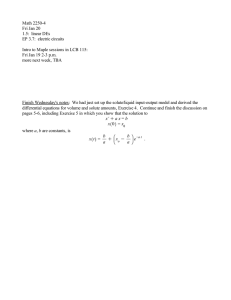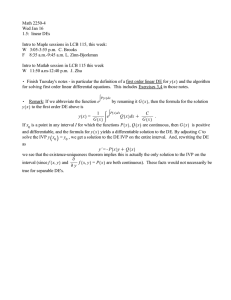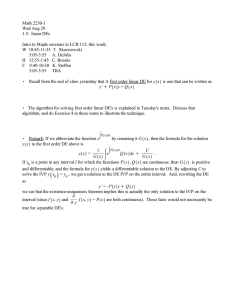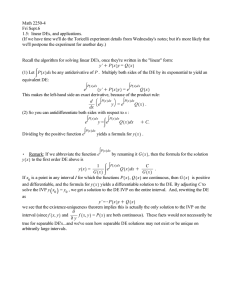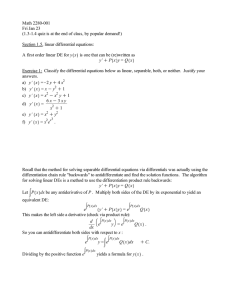Math 2250-010 Fri Jan 17
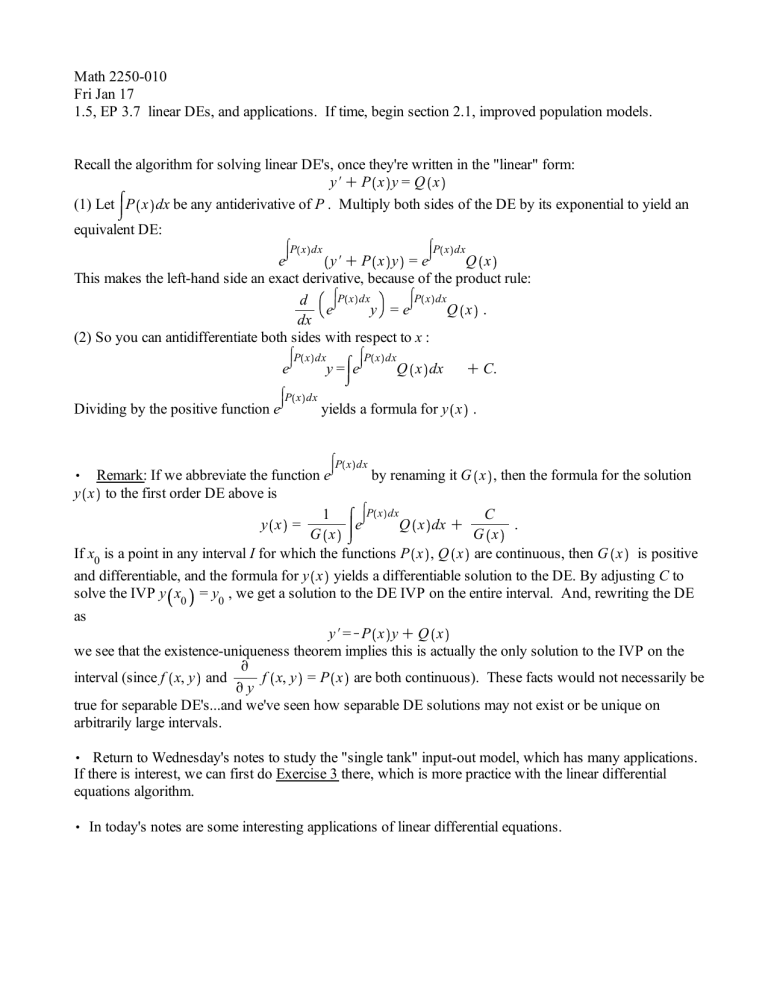
Math 2250-010
Fri Jan 17
1.5, EP 3.7 linear DEs, and applications. If time, begin section 2.1, improved population models.
Recall the algorithm for solving linear DE's, once they're written in the "linear" form: y # C P x y = Q x
(1) Let P x dx be any antiderivative of P . Multiply both sides of the DE by its exponential to yield an equivalent DE: e
P x dx y # C P x y = e
P x dx
Q x
This makes the left-hand side an exact derivative, because of the product rule: d dx e
P x dx y = e
P x dx
(2) So you can antidifferentiate both sides with respect to x :
Q x .
e
P x dx y = e
P x dx
Q x dx C C .
Dividing by the positive function e
P x dx
yields a formula for y x .
, Remark: If we abbreviate the function e y x to the first order DE above is
P x dx
by renaming it G x , then the formula for the solution y x =
1
G x e
P x dx
Q x dx C
C
G x
.
If x
0
is a point in any interval I for which the functions P x , Q x are continuous, then G x is positive and differentiable, and the formula for y x yields a differentiable solution to the DE. By adjusting C to solve the IVP y x
0 as
= y
0
, we get a solution to the DE IVP on the entire interval. And, rewriting the DE y # = K P x y C Q x we see that the existence-uniqueness theorem implies this is actually the only solution to the IVP on the v interval (since f x , y and f x , y = P x are both continuous). These facts would not necessarily be v y true for separable DE's...and we've seen how separable DE solutions may not exist or be unique on arbitrarily large intervals.
, Return to Wednesday's notes to study the "single tank" input-out model, which has many applications.
If there is interest, we can first do Exercise 3 there, which is more practice with the linear differential equations algorithm.
, In today's notes are some interesting applications of linear differential equations.
Exercise 1 (taken from section 1.5 of text) Solve the following pollution problem IVP, to answer the follow-up question: Lake Huron has a relatively constant concentration for a certain pollutant. Since Lake
Huron is the primary water source for Lake Erie, this is also the usual pollutant concentration in Lake Erie
Due to an industrial accident, however, Lake Erie has suddenly obtained a concentration five times as large. Lake Erie has a volume of 480 km
3
, and water flows into and out of Lake Erie at a rate of 350 km
3 per year. Essentially all of the in-flow is from Lake Huron (see below). We expect that as time goes by, the water from Lake Huron will flush out Lake Erie. Assuming that the pollutant concentration is roughly the same everywhere in Lake Erie, about how long will it be until this concentration is only twice the original background concentration from Lake Huron?
a) Set up the initial value problem. Maybe use symbols c for the background concentration (in Huron),
V r
= 480
= 350 km km y
3
3 b) Solve the IVP, and then answer the question.
http://www.enchantedlearning.com/usa/statesbw/greatlakesbw.GIF
EP 3.7 This is a supplementary section. I've posted a .pdf on our homework page.
Often the same DE can arise in completely different-looking situations. For example, first order linear
DE's also arise (as special cases of second order linear DE's) in simple RLC circuit modeling.
http://cnx.org/content/m21475/latest/pic012.png
Charge Q t coulombs accumulates on the capacitor, at a rate I t i t in the diagram above) amperes
(coulombs/sec), i.e Q # t = I t .
Kirchoff's Law: The sum of the voltage drops around any closed circuit loop equals the applied voltage
V t (volts). The units of voltage are energy units - Kirchoff's Law says that a test particle traversing any closed loop returns with the same potential energy level it started with:
For Q t : L Q ## t C R Q # t C
1
C
Q t = V t
For I t : L I ## t C R I # t C
1
C
I t = V # t if no inductor, or if no capacitor, then Kirchoff's Law yields 1 st
order linear DE's, as below:
Exercise 2: Consider the R K L circuit below, in which a switch is thrown at time t = 0. Assume the voltage V is constant, and I 0 = 0 . Find I t . Interpret your results.
http://www.intmath.com/differential-equations/5-rl-circuits.php
2.1 Improved population models
Let P t be a population at time t . Let's call them "people", although they could be other biological organisms, decaying radioactive elements, accumulating dollars, or even molecules of solute dissolved in a liquid at time t (2.1.23). Consider:
B t , birth rate (e.g. people year
) ; b t d
B t
P t
, fertility rate ( people year
per person )
D t , death rate (e.g. people year
); d t d
D
P t t
, mortality rate ( people year
per person )
Then in a closed system (i.e. no migration in or out) we can write the governing DE two equivalent ways:
P # t = B t K D t
P # t = b t K d t P t .
Model 1: constant fertility and mortality rates, b t h b
0
R 0, d t h d
0
R 0 , constants.
0 P # = b
0
K d
0
P = k P .
This is our familiar exponential growth/decay model, depending on whether k O 0 or k !
0 .
Model 2: population fertility and mortality rates only depend on population P , but they are not constant: b = b
0 d = d
0
C b
1
P
C d
1
P with b
0
, b
1
, d
0
, d
1
constants. This implies
P # = b K d P = b
0
= b
0
C
K d
0 b
1
P K d
0
C b
1
K
C d
1 d
1
P P
P P .
For viable populations, b
0 b
1
!
O d
0
. For a sophisticated (e.g. human) population we might also expect
0, and resource limitations might imply d
1
O 0. With these assumptions, and writing b
1
K d
1
!
0, b
0
K d
0
= b O 0 one obtains the logistic differential equation:
P
P # = b K a P P
P # = K a P
2
C b P , or equivalently
# = a P b a
K P = k P M K P .
k = a O 0, M = b a
O 0 . (One can consider other cases as well.)
= K a
Exercise 3: Discuss qualitative features of the slope field for the logistic differential equation for P = P t :
P # = k P M K P a) There are two constant ("equilibrium") solutions. What are they?
b) Evaluate the sign and magnitude of the slope function f P , t = k P M K P , in order to understand and be able to recreate the two diagrams below. One is a qualititative picture of the slope field, in the t K P plane. The diagram to the left of it, called the phase diagram , is just a P number line with arrows indicating whether P t is increasing or decreasing on the intervals between the constant solutions. c) When discussing the logistic equation, the value M is called the "carrying capacity" of the (ecological or other) system. Discuss why this is a good way to describe M . Hint: if P 0 = P
0
O 0 , and P t solves the logistic equation, what is the apparent value of lim
/ N
P t ?
Exercise 4: Solve the logistic DE IVP
P # = k P M K P
P 0 = P
0 via separation of variables. Verify that the solution formula is consistent with the slope field and phase diagram discussion from exercise 1. Hint: You should find that
P t =
MP
0
M K P
0 e C P
0
.
Solution (we will work this out step by step in class): dP
P P K M
= K k dt
By partial fractions,
1
P P K M
=
1
M
1
P K M
K
1
P
.
Use this expansion and multiply both sides of the separated DE by M to obtain
P
1
K M
K
1
P dP = K kM dt .
Integrate: ln P K M K ln P = K Mkt C C
1 ln
P K M
P
= K Mkt C C
1 exponentiate:
P K
P
M
= C
2 e
Since the left-side is continuous
P K
P
M
= C e ( C = C
2
or C = K C
2
)
(At t = 0 we see that
P
0
K M
P
0
= C .)
Now, solve for P t by multiplying both sides of of the second to last equation by P t :
P K M = Ce
Collect P t terms on left, and add M to both sides:
P
P
P
P
K
1
=
Ce
K Ce
M
P = M
= M
.
1 K Ce
Plug in C and simplify:
P =
1 K
P
0
M
K
P
0
M e
=
MP
0
P
0
K P
0
K M e
Finally, because lim
/ N e
P t =
= 0 , we see that
MP
0
P
0
C M K P
0 t lim
/ N
P t =
MP
0
P
0
= M e
.
as expected.
Note: If P
0
O 0 the denominator stays positive for t R 0, so we know that the formula for P t is a differentiable function for all t O 0. (If the denominator became zero, the function would blow up at the corresponding vertical asymptote.) To check that the denominator stays positive check that (i) if P
0
!
M then the denominator is a sum of two positive terms; if P
0
= M the separation algorithm actually fails because you divided by 0 to get started but the formula actually recovers the constant equilibrium solution
P t h M ; and if P
0
O M then M K P
0
!
P
0
so the second term in the denominator can never be negative enough to cancel out the positive P
0
, for t O 0 .)
